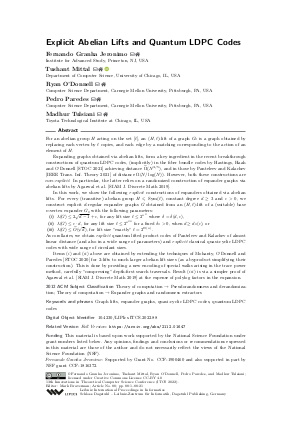@InProceedings{jeronimo_et_al:LIPIcs.ITCS.2022.88,
author = {Jeronimo, Fernando Granha and Mittal, Tushant and O'Donnell, Ryan and Paredes, Pedro and Tulsiani, Madhur},
title = {{Explicit Abelian Lifts and Quantum LDPC Codes}},
booktitle = {13th Innovations in Theoretical Computer Science Conference (ITCS 2022)},
pages = {88:1--88:21},
series = {Leibniz International Proceedings in Informatics (LIPIcs)},
ISBN = {978-3-95977-217-4},
ISSN = {1868-8969},
year = {2022},
volume = {215},
editor = {Braverman, Mark},
publisher = {Schloss Dagstuhl -- Leibniz-Zentrum f{\"u}r Informatik},
address = {Dagstuhl, Germany},
URL = {https://drops-dev.dagstuhl.de/entities/document/10.4230/LIPIcs.ITCS.2022.88},
URN = {urn:nbn:de:0030-drops-156846},
doi = {10.4230/LIPIcs.ITCS.2022.88},
annote = {Keywords: Graph lifts, expander graphs, quasi-cyclic LDPC codes, quantum LDPC codes}
}

 Creative Commons Attribution 4.0 International license
Creative Commons Attribution 4.0 International license
